 America celebrated July 4th with firecrackers and tributes to soldiers serving our country and commemorations to the legacy of the United States. As authors research for those bits of unexplored pieces of American history or add a fresh approach to familiar facts from previous eras, the Children’s Literature and Reading SIG of IRA presents a list of books for young readers that provides background and insight into the development of our country and its relationship with global neighbors throughout the world.
America celebrated July 4th with firecrackers and tributes to soldiers serving our country and commemorations to the legacy of the United States. As authors research for those bits of unexplored pieces of American history or add a fresh approach to familiar facts from previous eras, the Children’s Literature and Reading SIG of IRA presents a list of books for young readers that provides background and insight into the development of our country and its relationship with global neighbors throughout the world.
ReadWriteThink offers a plethora of American History Lessons that connect with literature ideas including “Fighting Injustice by Studying Lessons of the Past” to “Traveling the Road to Freedom through Research and Historical Fiction.”
Teachers might also enjoy using Museum Box, which was featured in an Engage blog post on September 26, 2012.
Educators will also find useful connections with the Notable Books for the Social Studies annual lists. The current 2013 list is available in the May/June issue of Social Education, and previous years’ lists are available at the Children’s Book Council website.
In addition, more award-winning social studies books are located at the CL/R website that sponsors The Notable Books for a Global Society Award.
GRADES K-2
Angleberger, Tom. (2013). Crankee Doodle. Illus. by Cece Bell. New York: Houghton Mifflin/Clarion Books.
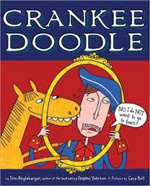 Most youngsters have enthusiastically belted out the words to the song "Yankee Doodle" only to pause in confusion as to the meaning of its lyrics. This hilarious story tells the story—or one of several possibilities—behind the song. As a pony tries to persuade his lethargic and reluctant owner to head into town, the cranky man comes up with several reasons for staying home. After all, he hates shopping and has no need to buy anything else. In fact, he swiftly rejects every suggestion the pony offers for going to town. After hurting the steed’s feelings, the grouchy man apologizes, and the last gouache illustration shows the two of them, loaded down with their purchases, having a blast now that they’ve finally gone to town. The very last page provides a historical note on the lyrics and what it could possibly mean to call a feather stuck to a hat by the name “macaroni.” Readers will hoot as they read this book, guaranteeing a surge in popularity for the song. Hilarious from beginning to end, this book is a perfect choice for any history class. Also check out author Tom Angleberger piece "A Book for Every Reader" on the Engage blog.
Most youngsters have enthusiastically belted out the words to the song "Yankee Doodle" only to pause in confusion as to the meaning of its lyrics. This hilarious story tells the story—or one of several possibilities—behind the song. As a pony tries to persuade his lethargic and reluctant owner to head into town, the cranky man comes up with several reasons for staying home. After all, he hates shopping and has no need to buy anything else. In fact, he swiftly rejects every suggestion the pony offers for going to town. After hurting the steed’s feelings, the grouchy man apologizes, and the last gouache illustration shows the two of them, loaded down with their purchases, having a blast now that they’ve finally gone to town. The very last page provides a historical note on the lyrics and what it could possibly mean to call a feather stuck to a hat by the name “macaroni.” Readers will hoot as they read this book, guaranteeing a surge in popularity for the song. Hilarious from beginning to end, this book is a perfect choice for any history class. Also check out author Tom Angleberger piece "A Book for Every Reader" on the Engage blog.
- Barbara A. Ward, Washington State University Pullman
Brown, Don. (2013). Henry and the cannons; an extraordinary true story of the American Revolution. New York: Roaring Brook Press/ Macmillan.
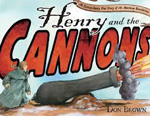 In the winter of 1775, the British occupied the city of Boston at the onset of the War for Independence. General George Washington was in charge of the newly formed American troops when a young bookseller named Henry Knox persuaded Washington to let him travel to Fort Ticonderoga, a wintery 300 miles away on the New York side of Lake Champlain, to bring 59 cannons back to Massachusetts. The cannons would provide the Americans the artillery needed to take the city of Boston away from the occupying British. Washington agreed, as Henry displayed his knowledge of military history and affairs, and so the arduous journey began. Henry devised a way of transporting the tons and tons of metal cannons using ropes and sleds, chains and boats to slowly move the artillery toward Boston. Crashing through the ice on one occasion did not deter the heroic efforts of Henry Knox and his men. When they reached Boston and delivered the cannons to Washington, the General quickly sent the British fleeing the city. Using quotes, primary source material, brief text and soft watercolor illustrations, this is a well-done introduction to one of those little-known stories of heroism during this early period of American history. Learn more about this author and his entire list of fiction and nonfiction books based on incidents from American history at his website.
In the winter of 1775, the British occupied the city of Boston at the onset of the War for Independence. General George Washington was in charge of the newly formed American troops when a young bookseller named Henry Knox persuaded Washington to let him travel to Fort Ticonderoga, a wintery 300 miles away on the New York side of Lake Champlain, to bring 59 cannons back to Massachusetts. The cannons would provide the Americans the artillery needed to take the city of Boston away from the occupying British. Washington agreed, as Henry displayed his knowledge of military history and affairs, and so the arduous journey began. Henry devised a way of transporting the tons and tons of metal cannons using ropes and sleds, chains and boats to slowly move the artillery toward Boston. Crashing through the ice on one occasion did not deter the heroic efforts of Henry Knox and his men. When they reached Boston and delivered the cannons to Washington, the General quickly sent the British fleeing the city. Using quotes, primary source material, brief text and soft watercolor illustrations, this is a well-done introduction to one of those little-known stories of heroism during this early period of American history. Learn more about this author and his entire list of fiction and nonfiction books based on incidents from American history at his website.
- Karen Hildebrand, Ohio Library and Reading Consultant
Cotten, Cynthia. (2013). The book boat’s in. Illus. by Frane Lessac. New York: Holiday House.
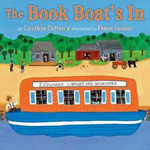 Teachers looking for books to celebrate literacy and the love of reading will want to add this book to their list. Set on the Erie Canal in rural 1835, young Jesse King loves to read and has read all the books on the shelf at his school that his teacher Miss Howard has managed to accumulate. When Jesse goes to town with his father one day, he notices that Mr. Edwards’ book boat is docked. Mr. Edwards travels up and down the Erie Canal renting and selling books to interested buyers and readers. Jesse spots his favorite book, The Swiss Family Robinson, in a red cover. His pa can’t afford to buy the book and suggests to Jesse that maybe he can do odd jobs and earn the money for the book on his next visit. Jesse agrees to this and offers to chop wood, work at the store, at a stable, sweeps for his neighbors until he has the money saved. When Mr. Edwards returns on the book boat, the red book is gone. Jesse is so disappointed until Mr. Edwards comes up with a suggestion. He has another copy of the book, not as fresh and nice as the red copy, but a bit worn and used-looking though still in decent condition. Jessie is thrilled not only to accept the suggestion but also to learn that it doesn’t cost as much as the red copy. Lessac’s folk-style primitive art illustrations enhance this era and the dialogue sets the scene for this time in early American history. Click here for a Q & A with the author for more background information about this real-life book boat or check out these teaching ideas at the author’s website.
Teachers looking for books to celebrate literacy and the love of reading will want to add this book to their list. Set on the Erie Canal in rural 1835, young Jesse King loves to read and has read all the books on the shelf at his school that his teacher Miss Howard has managed to accumulate. When Jesse goes to town with his father one day, he notices that Mr. Edwards’ book boat is docked. Mr. Edwards travels up and down the Erie Canal renting and selling books to interested buyers and readers. Jesse spots his favorite book, The Swiss Family Robinson, in a red cover. His pa can’t afford to buy the book and suggests to Jesse that maybe he can do odd jobs and earn the money for the book on his next visit. Jesse agrees to this and offers to chop wood, work at the store, at a stable, sweeps for his neighbors until he has the money saved. When Mr. Edwards returns on the book boat, the red book is gone. Jesse is so disappointed until Mr. Edwards comes up with a suggestion. He has another copy of the book, not as fresh and nice as the red copy, but a bit worn and used-looking though still in decent condition. Jessie is thrilled not only to accept the suggestion but also to learn that it doesn’t cost as much as the red copy. Lessac’s folk-style primitive art illustrations enhance this era and the dialogue sets the scene for this time in early American history. Click here for a Q & A with the author for more background information about this real-life book boat or check out these teaching ideas at the author’s website.
- Karen Hildebrand, Ohio Library and Reading Consultant
Pinborough, Jan. (2013). Miss Moore thought otherwise: How Anne Carroll Moore created libraries for children. Illus. by Debby Atwell. New York: Houghton Mifflin Books for Children.
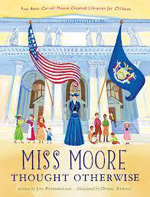 Young readers will surely be dismayed to learn that libraries were once places where children were not welcome; in fact, there were many libraries that didn't allow them to touch or even check out the books that rested on the library shelves. This inspiring title about independent-minded and determined Annie Carroll Moore, raised in Limerick, Maine, describes how she worked to make libraries places that welcomed children. The only daughter in a large family of boys, Annie refused to follow 19th century expectations for women. Instead, she studied law before moving to New York City to become a librarian. She reveled in the sights, sounds, and freedom of the burgeoning city and its streets filled with passersby. Not only did she update her own children's library collection, but when the New York Public Library was built, Moore took care to include features such as inviting window seats, new children's books, read alouds and visits from authors and famous individuals, including royalty, all intended to attract children. Hard-working librarians and those who are librarians at heart will relish this inspiring, loving tribute to a woman who "thought otherwise" (unpaged) about a lot of matters and often challenged the status quo. The acrylic illustrations have a folkloric quality to them, and the back matter includes brief notes about other librarians who helped create libraries for children.
Young readers will surely be dismayed to learn that libraries were once places where children were not welcome; in fact, there were many libraries that didn't allow them to touch or even check out the books that rested on the library shelves. This inspiring title about independent-minded and determined Annie Carroll Moore, raised in Limerick, Maine, describes how she worked to make libraries places that welcomed children. The only daughter in a large family of boys, Annie refused to follow 19th century expectations for women. Instead, she studied law before moving to New York City to become a librarian. She reveled in the sights, sounds, and freedom of the burgeoning city and its streets filled with passersby. Not only did she update her own children's library collection, but when the New York Public Library was built, Moore took care to include features such as inviting window seats, new children's books, read alouds and visits from authors and famous individuals, including royalty, all intended to attract children. Hard-working librarians and those who are librarians at heart will relish this inspiring, loving tribute to a woman who "thought otherwise" (unpaged) about a lot of matters and often challenged the status quo. The acrylic illustrations have a folkloric quality to them, and the back matter includes brief notes about other librarians who helped create libraries for children.
- Barbara A. Ward, Washington State University Pullman
Tuck, Pamela M. (2013). As fast as words could fly. Illus. by Eric Velasquez. New York: Lee and Low Books.
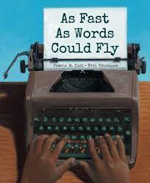 Based on the life of the author’s father, Pamela Tuck relives a moment in the civil rights movement of the 1960s in Greenville, North Carolina. Young Mason Steele is a good writer and when his activist father needs help writing letters to civil rights leaders or people who have discriminated against Negroes, he dictates letters that Mason puts into words and letters. At one point the local civil rights organization finds a way to get Mason a real typewriter to help with his father’s letters. One day, his father calls Mason and his two brothers into the kitchen and tells them they will be going to the all-white high school that is much closer than their segregated school. The boys are very nervous about this new turn in their lives especially when the school bus drives right on by them the first two days of school. When they finally get picked up they are made to sit in the back of the bus. Though Mason excels at school especially in typing class, it is a very strained and difficult school atmosphere for Mason and the other black students. Mason is able to get a job in the library typing cards for the school librarian that adds more experience to his typing skills. When his typing teacher, Mrs. Roberts, announces a tournament Mason is selected as the candidate to represent the school. At the contest, he has to choose between an electric and a manual typewriter for the tournament. He chooses the manual typewriter and when the contest begins, his fingers fly across the keyboard to win the tournament. No one cheers or applauds. No one congratulates Mason. Later, when his principal, Mr. Bullock, asked him why he chose the manual typewriter, Mason replied, “Cause it reminds me of where I come from, sir.” (p. 31) The book concludes with detailed notes from the author about her father’s experience and describes the civil rights movement of the 1960’s. Read more about the background of this story at the publisher’s website.
Based on the life of the author’s father, Pamela Tuck relives a moment in the civil rights movement of the 1960s in Greenville, North Carolina. Young Mason Steele is a good writer and when his activist father needs help writing letters to civil rights leaders or people who have discriminated against Negroes, he dictates letters that Mason puts into words and letters. At one point the local civil rights organization finds a way to get Mason a real typewriter to help with his father’s letters. One day, his father calls Mason and his two brothers into the kitchen and tells them they will be going to the all-white high school that is much closer than their segregated school. The boys are very nervous about this new turn in their lives especially when the school bus drives right on by them the first two days of school. When they finally get picked up they are made to sit in the back of the bus. Though Mason excels at school especially in typing class, it is a very strained and difficult school atmosphere for Mason and the other black students. Mason is able to get a job in the library typing cards for the school librarian that adds more experience to his typing skills. When his typing teacher, Mrs. Roberts, announces a tournament Mason is selected as the candidate to represent the school. At the contest, he has to choose between an electric and a manual typewriter for the tournament. He chooses the manual typewriter and when the contest begins, his fingers fly across the keyboard to win the tournament. No one cheers or applauds. No one congratulates Mason. Later, when his principal, Mr. Bullock, asked him why he chose the manual typewriter, Mason replied, “Cause it reminds me of where I come from, sir.” (p. 31) The book concludes with detailed notes from the author about her father’s experience and describes the civil rights movement of the 1960’s. Read more about the background of this story at the publisher’s website.
- Karen Hildebrand, Ohio Library and Reading Consultant
GRADES 3-5
Castrovilla, Selene. (2013). Revolutionary friends; General George Washington and the Marquis de Lafayette. Illus. by Drazen Kozjan. Honesdale, PA: Calkins Creek/ Boyds Mills Press.
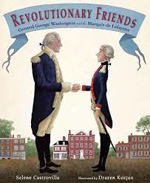 Using primary documents and direct quotes from the featured historical figures, author Selene Castrovilla has presented the background for the Marquis de Lafayette’s arrival in America to meet and help General George Washington in the War for Independence in 1777. Lafayette is just nineteen years old when defies his own king’s orders and leaves France to sail to America to fight for freedom and the patriotic cause. Washington is reluctant to accept this offer of assistance from the eager young nobleman but when Lafayette proves himself to be an excellent soldier at the Battle of Brandywine, Washington recognizes the young man’s abilities and sincerity to be part of the cause. The two men become good friends and when Lafayette is wounded in the leg, Washington tells the doctor to treat him as he would his own son. This excellent account of these two men is told with historical accuracy and detail, yet is a wordy picture book for younger readers. Three more additional pages at the end of the book continue giving additional background information including a glossary of the French words with definitions that are sprinkled through the book, places to visit, and a bibliography. Kozjan’s pen and ink illustrations are appealing and include parchment-style scrolled letters throughout the book that are taken from Lafayette’s letters and diaries. A detailed standards-based teacher’s guide is available at the author’s website.
Using primary documents and direct quotes from the featured historical figures, author Selene Castrovilla has presented the background for the Marquis de Lafayette’s arrival in America to meet and help General George Washington in the War for Independence in 1777. Lafayette is just nineteen years old when defies his own king’s orders and leaves France to sail to America to fight for freedom and the patriotic cause. Washington is reluctant to accept this offer of assistance from the eager young nobleman but when Lafayette proves himself to be an excellent soldier at the Battle of Brandywine, Washington recognizes the young man’s abilities and sincerity to be part of the cause. The two men become good friends and when Lafayette is wounded in the leg, Washington tells the doctor to treat him as he would his own son. This excellent account of these two men is told with historical accuracy and detail, yet is a wordy picture book for younger readers. Three more additional pages at the end of the book continue giving additional background information including a glossary of the French words with definitions that are sprinkled through the book, places to visit, and a bibliography. Kozjan’s pen and ink illustrations are appealing and include parchment-style scrolled letters throughout the book that are taken from Lafayette’s letters and diaries. A detailed standards-based teacher’s guide is available at the author’s website.
- Karen Hildebrand, Ohio Library and Reading Consultant
Giff, Patricia Reilly. (2013). Gingersnap. New York: Wendy Lamb Books/ Random House.
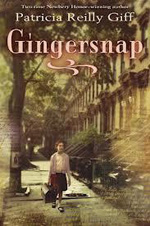 Set in upstate New York during World War II, eleven-year old Jayna lives with her older brother, Rob. Their parents were killed in an automobile accident years ago and Rob has taken care of Jayna since that time. Rob is a cook in the Navy and when he is called into the war to serve as a cook on a submarine, Rob makes arrangements for Jayna to stay in the apartment under the watchful eye of Celine, their landlord. Jayna is not happy with this arrangement and when she receives word that Rob’s submarine was attacked and he is MIA, Jayne decides to look for family, possibly her grandmother, in Brooklyn. Inside a blue cookbook that Rob left behind is a photo with an inscription and an address in Brooklyn. When a ghostly presence encourages Jayna to find the person in the photo, she packs up a few belongings, including her pet turtle named Theresa, and takes the bus to New York City. She has convinced herself that the ghost she is sensing is her mother guiding her to New York. When she arrives and eventually finds the bakery in the photo that she has nicknamed Gingersnap and a woman named Elise, Jayna discovers friends and family that help her through this time of war and uncertainty. A book about war and deployment, separated families, the concern and not knowing about loved ones are certainly topics for today as well as yesterday. Teachers will find a quick booktalk for this book at Jenny Sawyer’s “Pick of the Week” on YouTube.
Set in upstate New York during World War II, eleven-year old Jayna lives with her older brother, Rob. Their parents were killed in an automobile accident years ago and Rob has taken care of Jayna since that time. Rob is a cook in the Navy and when he is called into the war to serve as a cook on a submarine, Rob makes arrangements for Jayna to stay in the apartment under the watchful eye of Celine, their landlord. Jayna is not happy with this arrangement and when she receives word that Rob’s submarine was attacked and he is MIA, Jayne decides to look for family, possibly her grandmother, in Brooklyn. Inside a blue cookbook that Rob left behind is a photo with an inscription and an address in Brooklyn. When a ghostly presence encourages Jayna to find the person in the photo, she packs up a few belongings, including her pet turtle named Theresa, and takes the bus to New York City. She has convinced herself that the ghost she is sensing is her mother guiding her to New York. When she arrives and eventually finds the bakery in the photo that she has nicknamed Gingersnap and a woman named Elise, Jayna discovers friends and family that help her through this time of war and uncertainty. A book about war and deployment, separated families, the concern and not knowing about loved ones are certainly topics for today as well as yesterday. Teachers will find a quick booktalk for this book at Jenny Sawyer’s “Pick of the Week” on YouTube.
- Karen Hildebrand, Ohio Library and Reading Consultant
Gigliotti, Jim. (2013). I am Roberto Clemente. New York: Scholastic.
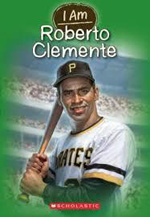 Baseball has long been an important part of American history, and has been noted for its part in the breaking of the barrier between races. This brief biography celebrates the heralded Roberto Clemente who faced much prejudice when he moved from Puerto Rico to play his favorite sport. At first, newspapers even made fun of his accent and the way he spoke when they wrote articles about him. Although Clemente is best known for his feats on the baseball field as he led the Pittsburg Pirates to the World Series title twice, he is also known for his humanitarian acts. The first Latin American to be inducted into the National Baseball Hall of Fame, Clemente gave generously of his time and money to various causes. His unexpected death in a plane crash while en route to Nicaragua with needed supplies even caused the governor of Puerto Rico to cancel his planned inauguration ceremonies. Elementary students will enjoy the details about his upbringing and his passion for baseball as well as his total dedication to his sport, his devotion to his family, and his compassion for anyone in need. This brief biography provides insight into Clemente’s personality and the challenges he faced throughout his life ball. To read his story is to be inspired by his heroism both on and off the baseball field.
Baseball has long been an important part of American history, and has been noted for its part in the breaking of the barrier between races. This brief biography celebrates the heralded Roberto Clemente who faced much prejudice when he moved from Puerto Rico to play his favorite sport. At first, newspapers even made fun of his accent and the way he spoke when they wrote articles about him. Although Clemente is best known for his feats on the baseball field as he led the Pittsburg Pirates to the World Series title twice, he is also known for his humanitarian acts. The first Latin American to be inducted into the National Baseball Hall of Fame, Clemente gave generously of his time and money to various causes. His unexpected death in a plane crash while en route to Nicaragua with needed supplies even caused the governor of Puerto Rico to cancel his planned inauguration ceremonies. Elementary students will enjoy the details about his upbringing and his passion for baseball as well as his total dedication to his sport, his devotion to his family, and his compassion for anyone in need. This brief biography provides insight into Clemente’s personality and the challenges he faced throughout his life ball. To read his story is to be inspired by his heroism both on and off the baseball field.
- Barbara A. Ward, Washington State University Pullman
Norwich, Grace. (2013). I am Harriet Tubman. Illus. by New York: Scholastic.
 Harriet Tubman may have been diminutive in size, but there was certainly nothing small about her courage or her actions. This exciting biography of the woman who not only made her way to freedom but returned time and again to help others escape is filled with anecdotes that attest to her bravery. After an introduction that provides a glimpse into the life of Harriet Tubman, born a slave with many strikes against her, the book traces her early years and the harsh treatment she endured before trying to escape to freedom. The writer makes readers feel as though they are right alongside this fearless woman, somehow finding the courage to venture south again and again as she led others, many of them her relatives, to a better life. Young readers will feel dismayed and disheartened to learn that she was never compensated for the work she performed for the Union Army during the Civil War. While many readers will be familiar with her travels on the Underground Railroad, few will realize that she led an army, served as a spy, and advocated for better treatment of the elderly as well as being involved in the civil rights and women's suffrage movements. Like the other titles in the "I Am..." series, this one provides interesting biographical details missing from many history texts and lists websites that allow readers to trace Harriet's footsteps on the path to freedom.
Harriet Tubman may have been diminutive in size, but there was certainly nothing small about her courage or her actions. This exciting biography of the woman who not only made her way to freedom but returned time and again to help others escape is filled with anecdotes that attest to her bravery. After an introduction that provides a glimpse into the life of Harriet Tubman, born a slave with many strikes against her, the book traces her early years and the harsh treatment she endured before trying to escape to freedom. The writer makes readers feel as though they are right alongside this fearless woman, somehow finding the courage to venture south again and again as she led others, many of them her relatives, to a better life. Young readers will feel dismayed and disheartened to learn that she was never compensated for the work she performed for the Union Army during the Civil War. While many readers will be familiar with her travels on the Underground Railroad, few will realize that she led an army, served as a spy, and advocated for better treatment of the elderly as well as being involved in the civil rights and women's suffrage movements. Like the other titles in the "I Am..." series, this one provides interesting biographical details missing from many history texts and lists websites that allow readers to trace Harriet's footsteps on the path to freedom.
- Barbara A. Ward, Washington State University Pullman
Parry, Roseanne. (2013). Written in stone. New York: Random House.
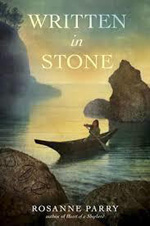 As the story opens in 1999, the old Makah Indian woman named Pearl recalls her childhood and the tragedies that sent her life in an unplanned direction. Living on the coast of the Pacific Northwest, it was the flu pandemic of 1918 that took her mother and sister when Pearl was five years old. She and her father survived through his whaling trade. A whale hunt ended his life when Pearl was thirteen, so she went to live with members of the tribe and her extended family. Difficult times were ahead for the Native Americans as modern technology harvested the whales with steam-powered harpoon cannons leaving little for the canoe whalers of the Makah. One day a New Yorker arrives at the tribe and wants to purchase Native artifacts and artwork. Pearl is immediately suspicious of this man and discovers that his real agenda is to obtain the mineral rights of their rich oil deposits on Native land. Pearl struggles without her family for guidance and turns to her Aunt Susi who has adopted some of the ways of the new century like driving a car and working at the post office. The author taught school on the Quinault Indian reservation and developed a sincere appreciation of the customs, traditions, and art of the natives of the northwest. A coming of age novel set against an actual historical event will bring this part of the country to readers not familiar with this group of Native Americans. From the author’s website, she links readers to her Pinterest board that extends many of the concepts in her new book.
As the story opens in 1999, the old Makah Indian woman named Pearl recalls her childhood and the tragedies that sent her life in an unplanned direction. Living on the coast of the Pacific Northwest, it was the flu pandemic of 1918 that took her mother and sister when Pearl was five years old. She and her father survived through his whaling trade. A whale hunt ended his life when Pearl was thirteen, so she went to live with members of the tribe and her extended family. Difficult times were ahead for the Native Americans as modern technology harvested the whales with steam-powered harpoon cannons leaving little for the canoe whalers of the Makah. One day a New Yorker arrives at the tribe and wants to purchase Native artifacts and artwork. Pearl is immediately suspicious of this man and discovers that his real agenda is to obtain the mineral rights of their rich oil deposits on Native land. Pearl struggles without her family for guidance and turns to her Aunt Susi who has adopted some of the ways of the new century like driving a car and working at the post office. The author taught school on the Quinault Indian reservation and developed a sincere appreciation of the customs, traditions, and art of the natives of the northwest. A coming of age novel set against an actual historical event will bring this part of the country to readers not familiar with this group of Native Americans. From the author’s website, she links readers to her Pinterest board that extends many of the concepts in her new book.
- Karen Hildebrand, Ohio Library and Reading Consultant
Selbert, Kathryn. (2013). War dogs: Churchill and Rufus. Watertown, MA: Charlesbridge.
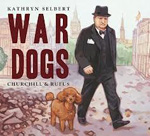 While young readers will require background material on WWII and Winston Churchill before reading this book, they are sure to be interested in the strong bond between the British Prime Minister and his beloved miniature poodle, Rufus. Since the back matter offers a photograph and information about the two, they may be fascinated to learn more about the dog who sat in Churchill's speech at the House of Commons and kept his master's spirits up during the long war with Germany. The book almost reads like a memoir, told in fits and starts, accompanied by quotations from Churchill on note cards held in place with pushpins. The back matter explaining the origin of Churchill's nickname and reputation for doggedness may aid in explaining the book's title, content, and final lines. Depicting the nation and London during idyllic times of peace and during its darkest days after the Germans had destroyed much of the city, the acrylic and collage illustrations are eye-catching. Through it all, Rufus remained loyally by his master's side.
While young readers will require background material on WWII and Winston Churchill before reading this book, they are sure to be interested in the strong bond between the British Prime Minister and his beloved miniature poodle, Rufus. Since the back matter offers a photograph and information about the two, they may be fascinated to learn more about the dog who sat in Churchill's speech at the House of Commons and kept his master's spirits up during the long war with Germany. The book almost reads like a memoir, told in fits and starts, accompanied by quotations from Churchill on note cards held in place with pushpins. The back matter explaining the origin of Churchill's nickname and reputation for doggedness may aid in explaining the book's title, content, and final lines. Depicting the nation and London during idyllic times of peace and during its darkest days after the Germans had destroyed much of the city, the acrylic and collage illustrations are eye-catching. Through it all, Rufus remained loyally by his master's side.
- Barbara A. Ward, Washington State University Pullman
Stringer, Lauren. (2013). When Stravinsky met Nijinsky: Two artists, their ballet, and one extraordinary riot. New York: Houghton Mifflin Harcourt Books for Children.
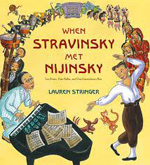 A century after the groundbreaking ballet, The Rite of Spring, debuted in Paris, this picture book describes the creative partnership between composer Igor Stravinsky and dancer and choreographer Vaslav Nijinsky. Daringly, these talented artists collaborated on a ballet whose score changed music and dance forever. They drew upon Russian folk songs and dances to compose music that the musicians could play by "drumming their feet and beating their drums/ to rollicking chords and rhythms offbeat" (unpaged). It's hard to imagine how divided the audience for that first performance was, enough to prompt both boos and bravos and a riot that began in the performance hall’s aisles and then continued into the city streets. The engaging text is filled with delicious phrases as Stravinsky imagines "night drums that rumble and fires that blaze" (unpaged) or how Nijinsky's "torso trumpeted a melody" (unpaged). The color-splashed acrylic illustrations are striking in their depiction of these creative, kindred spirits willing to take risks as well as the performers and musicians who stuck by them. Back matter includes information about the artistic tributes hidden within the illustrations and details about the ballet's creators, the ballet itself, and photographs.
A century after the groundbreaking ballet, The Rite of Spring, debuted in Paris, this picture book describes the creative partnership between composer Igor Stravinsky and dancer and choreographer Vaslav Nijinsky. Daringly, these talented artists collaborated on a ballet whose score changed music and dance forever. They drew upon Russian folk songs and dances to compose music that the musicians could play by "drumming their feet and beating their drums/ to rollicking chords and rhythms offbeat" (unpaged). It's hard to imagine how divided the audience for that first performance was, enough to prompt both boos and bravos and a riot that began in the performance hall’s aisles and then continued into the city streets. The engaging text is filled with delicious phrases as Stravinsky imagines "night drums that rumble and fires that blaze" (unpaged) or how Nijinsky's "torso trumpeted a melody" (unpaged). The color-splashed acrylic illustrations are striking in their depiction of these creative, kindred spirits willing to take risks as well as the performers and musicians who stuck by them. Back matter includes information about the artistic tributes hidden within the illustrations and details about the ballet's creators, the ballet itself, and photographs.
- Barbara A. Ward, Washington State University Pullman
Tarshis, Lauren. (2013). The battle of Gettysburg, 1863. Illus. by Scott Dawson. New York: Scholastic.
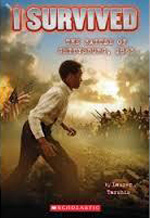
Book #7 in the “I Survived” series written by Tarshis, this volume provides a clear look at the Civil War through story and fact. Thomas and his little sister Birdie, former slaves, are trying to make their way north to find freedom and a new life. Thomas and Birdie come upon Henry Green, a wounded Union soldier captured by the Confederates. They help Henry escape by throwing a live skunk at the Rebs. As they make their way back to Henry’s unit, the Yankee soldiers take in Thomas and Birdie. The troops move toward Gettysburg where Thomas finds himself in the thick of the war and the Battle of Gettysburg itself. When the war is over, the brother and sister reunite with their cousin Clem and make their way to Vermont, to the parents of Henry Green, the Union soldier they helped. The author describes camp life and military battles with language appropriate for intermediate readers of American history. She ends the book with Q & A about the Civil War, the Gettysburg Address, and an annotated bibliography/reading list. The Scholastic website offers a guide to the “I Survived” series that include CCSS connections in addition to the resources found at the author’s website.
- Karen Hildebrand, Ohio Library and Reading Consultant
GRADES 5-8
Freedman, Russell. (2013). Becoming Ben Franklin: How a candle-maker’s son helped light the flame of liberty. New York: Holiday House.
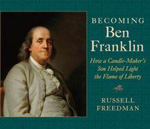 With his inimitable prose and attention to details sure to intrigue young readers, the author uses nine chapters to describe the life and times of Benjamin Franklin. Having left an apprenticeship with his brother and been lured to London with the promise of financial support from the governor of Pennsylvania—a promise that wasn’t kept—the teenage Franklin had every right to become bitter. Instead, as he would the rest of his life, he made the best of his situation and his gift with words. Upon his return to Philadelphia, he made his fortune by publishing Poor Richard’s Almanack, filled with clever sayings and weather forecasts. Young readers will thrill at Franklin’s rag-to-riches story, filled as it is with humor, determination, original thinking, and risk-taking. Naysayers who doubt the power of the printed and spoken word will find evidence to the contrary in this volume. The inclusion of illustrations and documents from the time period embellish an already-fascinating true tale about one of the nation’s founders.
With his inimitable prose and attention to details sure to intrigue young readers, the author uses nine chapters to describe the life and times of Benjamin Franklin. Having left an apprenticeship with his brother and been lured to London with the promise of financial support from the governor of Pennsylvania—a promise that wasn’t kept—the teenage Franklin had every right to become bitter. Instead, as he would the rest of his life, he made the best of his situation and his gift with words. Upon his return to Philadelphia, he made his fortune by publishing Poor Richard’s Almanack, filled with clever sayings and weather forecasts. Young readers will thrill at Franklin’s rag-to-riches story, filled as it is with humor, determination, original thinking, and risk-taking. Naysayers who doubt the power of the printed and spoken word will find evidence to the contrary in this volume. The inclusion of illustrations and documents from the time period embellish an already-fascinating true tale about one of the nation’s founders.
- Barbara A. Ward, Washington State University Pullman
Frost, Helen. (2013). Salt; a story of friendship in time of war. New York: Farrar, Straus and Giroux/Macmillan.
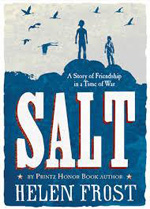 From master novel in verse author, Helen Frost, her new novel delves into the friendship of two twelve-year old boys in 1812 Indiana Territory. Anikwa is Native American of the Miami tribe and James Gray is a white settler and the son of a trader. The two boys alternate the poetic narration as the War of 1812 approaches and the Native Americans plan to join with the British forces to fight against the newly organized Americans. The boys’ friendship is strained as the two sides line up against each other. James’ family is dependent on both factions as a trader and supplier of local settlers but trade goods with the local tribes, especially the precious commodity of salt. Entwined between the two boys’ thoughts and fears about the coming war are poems about salt, the necessary substance on which both the Miami and the settlers have come to depend. In Frost’s unique style her poems take meaningful shape within the story line. Anikwa’s story unfolds through verses in the shape of patterns based on Miami ribbon work while James’ story is told in a more linear style fashioned after the stars and stripes of the American flag. This sensitive and beautifully written story about cross-cultural similarities and differences is an outstanding contribution to this period of history. The author’s website offers more information on the book including a link to the Online Myaamia Dictionary which offers pronunciation help with the Native American words.
From master novel in verse author, Helen Frost, her new novel delves into the friendship of two twelve-year old boys in 1812 Indiana Territory. Anikwa is Native American of the Miami tribe and James Gray is a white settler and the son of a trader. The two boys alternate the poetic narration as the War of 1812 approaches and the Native Americans plan to join with the British forces to fight against the newly organized Americans. The boys’ friendship is strained as the two sides line up against each other. James’ family is dependent on both factions as a trader and supplier of local settlers but trade goods with the local tribes, especially the precious commodity of salt. Entwined between the two boys’ thoughts and fears about the coming war are poems about salt, the necessary substance on which both the Miami and the settlers have come to depend. In Frost’s unique style her poems take meaningful shape within the story line. Anikwa’s story unfolds through verses in the shape of patterns based on Miami ribbon work while James’ story is told in a more linear style fashioned after the stars and stripes of the American flag. This sensitive and beautifully written story about cross-cultural similarities and differences is an outstanding contribution to this period of history. The author’s website offers more information on the book including a link to the Online Myaamia Dictionary which offers pronunciation help with the Native American words.
- Karen Hildebrand, Ohio Library and Reading Consultant
Hughes, Shirley. (2013). Hero on a bicycle. Somerville, MA: Candlewick Press.
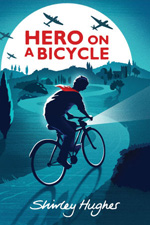 Picture book author Shirley Hughes as ventured into her first novel for middle grade readers. Set in 1944 against the backdrop of Nazi-occupied Florence, Italy, teenage brother and older sister Paolo and Costanza Crivelli want to do something to assist the resistance movement. Their father is away working with the Partisans and their English-born mother is under suspicion by occupying German forces. Violating curfew, Paolo often sneaks out at night to ride through the streets of Florence to seek out adventure as well as information, always careful to avoid the soldiers guarding the city. He dreams of ways to become a hero as so many aspects of war surround him. He soon discovers that his mother is aiding the Partisans by hiding Allied POWs in their cellar. As the suspense mounts and the small family group is unsure whom to trust, the realities of war are exposed. The narration moves from one family member to the other so readers discover how each character feels and reacts to the clandestine operations they find themselves a part. This excellent presentation of World War II and the efforts of people involved in resistance is an exciting addition to the list of books during this period of world history. The author has created a wonderful website devoted to the background of this story that include photos, video, sketches and detailed information.
Picture book author Shirley Hughes as ventured into her first novel for middle grade readers. Set in 1944 against the backdrop of Nazi-occupied Florence, Italy, teenage brother and older sister Paolo and Costanza Crivelli want to do something to assist the resistance movement. Their father is away working with the Partisans and their English-born mother is under suspicion by occupying German forces. Violating curfew, Paolo often sneaks out at night to ride through the streets of Florence to seek out adventure as well as information, always careful to avoid the soldiers guarding the city. He dreams of ways to become a hero as so many aspects of war surround him. He soon discovers that his mother is aiding the Partisans by hiding Allied POWs in their cellar. As the suspense mounts and the small family group is unsure whom to trust, the realities of war are exposed. The narration moves from one family member to the other so readers discover how each character feels and reacts to the clandestine operations they find themselves a part. This excellent presentation of World War II and the efforts of people involved in resistance is an exciting addition to the list of books during this period of world history. The author has created a wonderful website devoted to the background of this story that include photos, video, sketches and detailed information.
- Karen Hildebrand, Ohio Library and Reading Consultant
Pinkney, Andrea Davis. (2013). Peace warriors. New York: Scholastic.
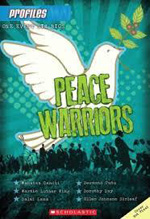 Recognizing that there are connections among many of the individuals typically associated with various movements for change gave rise to the Profiles series that tells the stories of several men and women. By reading multiple, related stories, readers can see how one man or woman can influence another and then he/she, in turn, influences someone else. All of this can lead to worldwide change. While some of the names in this book will be familiar, for instance, Desmond Tutu, the Dalai Lama, Mahatma Gandhi, Martin Luther King, Jr., others such as Dorothy Day and Ellen Johnson Sirleaf may not be as well-known although their lives and contributions are just as important as the more-famous figures. The six biographies in this book describe the childhood, family life, major accomplishments, and the ways in which the subjects’ lives influenced each other. For example, Noble Peace Prize-winner Sirleaf, president of Liberia, was the first woman to be elected as president of an African country. Her concern about the rights of women and the impoverished helped her win the election. Pacifist Dorothy Day spent her entire life working for equality for everyone and was particularly concerned about the plight of the homeless and unemployed. Accompanied by black and white photographs, the stories offer glimpses into the global contributions of these six inspiring and dedicated men and women who used their words and deeds as warriors for peace, surely a cause worth supporting.
Recognizing that there are connections among many of the individuals typically associated with various movements for change gave rise to the Profiles series that tells the stories of several men and women. By reading multiple, related stories, readers can see how one man or woman can influence another and then he/she, in turn, influences someone else. All of this can lead to worldwide change. While some of the names in this book will be familiar, for instance, Desmond Tutu, the Dalai Lama, Mahatma Gandhi, Martin Luther King, Jr., others such as Dorothy Day and Ellen Johnson Sirleaf may not be as well-known although their lives and contributions are just as important as the more-famous figures. The six biographies in this book describe the childhood, family life, major accomplishments, and the ways in which the subjects’ lives influenced each other. For example, Noble Peace Prize-winner Sirleaf, president of Liberia, was the first woman to be elected as president of an African country. Her concern about the rights of women and the impoverished helped her win the election. Pacifist Dorothy Day spent her entire life working for equality for everyone and was particularly concerned about the plight of the homeless and unemployed. Accompanied by black and white photographs, the stories offer glimpses into the global contributions of these six inspiring and dedicated men and women who used their words and deeds as warriors for peace, surely a cause worth supporting.
- Barbara A. Ward, Washington State University Pullman
Timberlake, Amy. (2013). One came home. New York: Alfred A. Knopf/Random House.
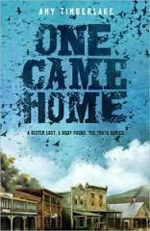 Georgie Burkhardt’s life in 1871, in Placid, Wisconsin, is very busy as she helps her Ma and Grandfather in their general store. Georgie is well known for her crack shooting ability with a rifle and also for her outspoken tongue. Her older sister Agatha hopes to go to college one day but that is a formidable dream in this time and place. When Agatha runs off one night without telling anyone and joins the group of pigeoners who are following the nesting migration of passenger pigeons, Georgie and her family and the suitors Agatha left behind are shocked when a dead body is found and identified as Agatha. Georgie refuses to accept that Agatha is dead. The body had been left outside in the elements and so was not easy to identify, only the dress and hair seemed to be Agatha’s. Georgie sets off on a rather uncontrollable mule to find out what happened. Billy McCabe, one of Amanda’s former boyfriends, soon joins her. Georgie’s fresh and straightforward dialogue adds the comic relief to this story of history and mystery. As Georgie and Billy journey together they encounter a counterfeit scheme, wild animals and the actual path and information about the passenger pigeon nesting and movement. Set against actual events in early Wisconsin, Georgie’s adventure is honest as well as exciting. Visit the author’s website for a detailed and downloadable teacher’s guide.
Georgie Burkhardt’s life in 1871, in Placid, Wisconsin, is very busy as she helps her Ma and Grandfather in their general store. Georgie is well known for her crack shooting ability with a rifle and also for her outspoken tongue. Her older sister Agatha hopes to go to college one day but that is a formidable dream in this time and place. When Agatha runs off one night without telling anyone and joins the group of pigeoners who are following the nesting migration of passenger pigeons, Georgie and her family and the suitors Agatha left behind are shocked when a dead body is found and identified as Agatha. Georgie refuses to accept that Agatha is dead. The body had been left outside in the elements and so was not easy to identify, only the dress and hair seemed to be Agatha’s. Georgie sets off on a rather uncontrollable mule to find out what happened. Billy McCabe, one of Amanda’s former boyfriends, soon joins her. Georgie’s fresh and straightforward dialogue adds the comic relief to this story of history and mystery. As Georgie and Billy journey together they encounter a counterfeit scheme, wild animals and the actual path and information about the passenger pigeon nesting and movement. Set against actual events in early Wisconsin, Georgie’s adventure is honest as well as exciting. Visit the author’s website for a detailed and downloadable teacher’s guide.
- Karen Hildebrand, Ohio Library and Reading Consultant
GRADES 9-12
Larson, Kirby. (2013). Hattie ever after. New York: Delacorte Press/ Random House.
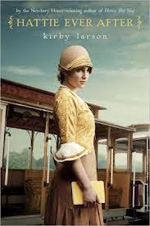 The sequel to Newbery Honor Book, Hattie Big Sky (2006), Larson’s new book continues Hattie’s story in 1919 as she leaves the Montana homestead to travel to San Francisco. Kirby Larson’s research into the politics and fashions of the time set the tone as Hattie tries to become a newspaper reporter, a job that traditionally has not been for women. Hattie is willing to work her way up to reporter and that includes cleaning the offices at the San Francisco Chronicle newspaper office which leads to becoming a researcher and a stringer before getting to actual reporting. She is on the search for a big story that will establish her career. With nods to the fame of Nellie Bly and Ida Tarbell, Hattie has her mind made up. She also wants to find out more about her deceased and mysterious Uncle Chester. Though she still questions whether she made the right decision to come to San Francisco and especially her decision to postpone thinking about Charlie Hawley’s marriage proposal and moving to Seattle to settle down with him, she is determined to have a career in journalism. Hattie experiences both the ups and downs of big city life and her small-town adjustments and interpretations of urban life as she is swindled by a con artist and jostled by the crowds of people. On the other hand, opportunities wait especially when she is trapped on an elevator with President Woodrow Wilson. For fans of the first Hattie adventure, readers will enjoy reading about Hattie’s next steps. Also read "Digging for Details that Make Historical Fiction Delicious" by author Kirby Larson on the Engage blog.
The sequel to Newbery Honor Book, Hattie Big Sky (2006), Larson’s new book continues Hattie’s story in 1919 as she leaves the Montana homestead to travel to San Francisco. Kirby Larson’s research into the politics and fashions of the time set the tone as Hattie tries to become a newspaper reporter, a job that traditionally has not been for women. Hattie is willing to work her way up to reporter and that includes cleaning the offices at the San Francisco Chronicle newspaper office which leads to becoming a researcher and a stringer before getting to actual reporting. She is on the search for a big story that will establish her career. With nods to the fame of Nellie Bly and Ida Tarbell, Hattie has her mind made up. She also wants to find out more about her deceased and mysterious Uncle Chester. Though she still questions whether she made the right decision to come to San Francisco and especially her decision to postpone thinking about Charlie Hawley’s marriage proposal and moving to Seattle to settle down with him, she is determined to have a career in journalism. Hattie experiences both the ups and downs of big city life and her small-town adjustments and interpretations of urban life as she is swindled by a con artist and jostled by the crowds of people. On the other hand, opportunities wait especially when she is trapped on an elevator with President Woodrow Wilson. For fans of the first Hattie adventure, readers will enjoy reading about Hattie’s next steps. Also read "Digging for Details that Make Historical Fiction Delicious" by author Kirby Larson on the Engage blog.
- Karen Hildebrand, Ohio Library and Reading Consultant
These reviews are submitted by members of the International Reading Association's Children's Literature and Reading Special Interest Group (CL/R SIG) and are published weekly on Reading Today Online. The International Reading Association partners with the National Council of Teachers of English and Verizon Thinkfinity to produce ReadWriteThink.org, a website devoted to providing literacy instruction and interactive resources for grades K–12.